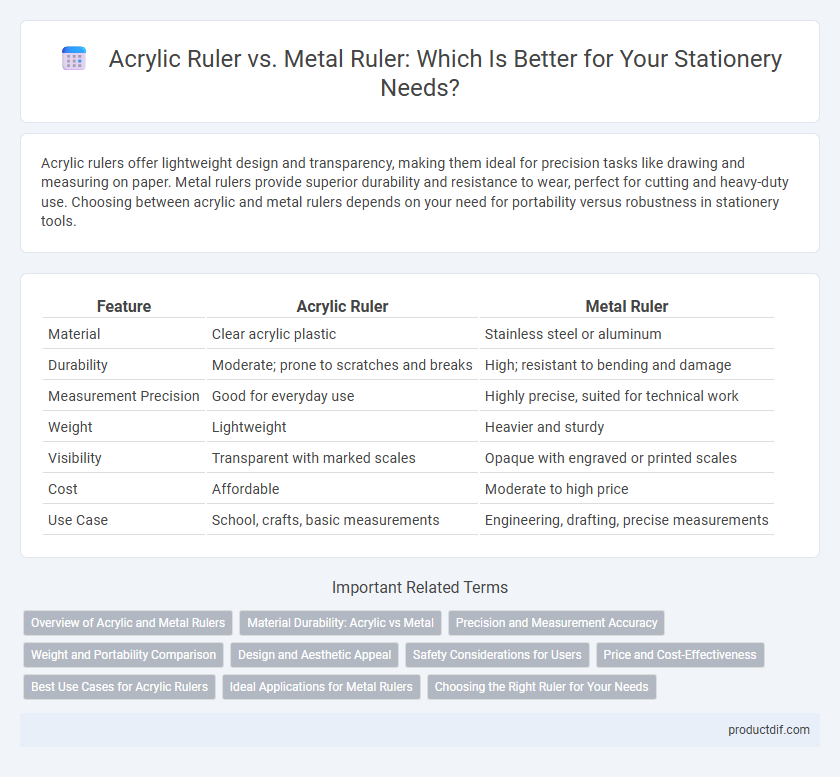Acrylic rulers offer lightweight design and transparency, making them ideal for precision tasks like drawing and measuring on paper. Metal rulers provide superior durability and resistance to wear, perfect for cutting and heavy-duty use. Choosing between acrylic and metal rulers depends on your need for portability versus robustness in stationery tools.
Table of Comparison
| Feature | Acrylic Ruler | Metal Ruler |
|---|---|---|
| Material | Clear acrylic plastic | Stainless steel or aluminum |
| Durability | Moderate; prone to scratches and breaks | High; resistant to bending and damage |
| Measurement Precision | Good for everyday use | Highly precise, suited for technical work |
| Weight | Lightweight | Heavier and sturdy |
| Visibility | Transparent with marked scales | Opaque with engraved or printed scales |
| Cost | Affordable | Moderate to high price |
| Use Case | School, crafts, basic measurements | Engineering, drafting, precise measurements |
Overview of Acrylic and Metal Rulers
Acrylic rulers offer transparency for precise measurements and are lightweight, making them ideal for drawing and crafting tasks. Metal rulers, typically made of stainless steel or aluminum, provide superior durability and resistance to wear, ensuring accurate straight edges for cutting and industrial use. Both types include etched markings for readability, but metal rulers excel in longevity and strength, while acrylic rulers prioritize visibility and ease of use.
Material Durability: Acrylic vs Metal
Acrylic rulers offer lightweight flexibility but are prone to scratching and breaking under high pressure, making them less durable than metal rulers. Metal rulers, typically made from stainless steel or aluminum, provide superior durability with resistance to bending, rust, and wear, ensuring long-term precision. The choice between acrylic and metal rulers depends largely on the need for lightweight convenience versus rugged, lasting material strength in various stationery applications.
Precision and Measurement Accuracy
Acrylic rulers offer clear visibility and smooth edges, enabling precise alignment for detailed measurements, especially in art and drafting. Metal rulers provide superior durability and maintain straightness over time, ensuring consistent measurement accuracy in engineering and technical work. Both types deliver precise measurement, but metal rulers excel in long-term reliability and resistance to wear.
Weight and Portability Comparison
Acrylic rulers are lightweight and easy to carry, making them ideal for students and professionals on the go. Metal rulers, although heavier, offer greater durability but can be less portable for everyday use. Choosing between the two depends on the balance between portability needs and sturdiness preferences.
Design and Aesthetic Appeal
Acrylic rulers often feature transparent designs that allow for easy visibility of measurements and underlying surfaces, making them popular for drawing and crafting tasks requiring precision. Metal rulers, in contrast, offer a sleek, industrial aesthetic with a polished or brushed finish that appeals to users seeking durability and a professional look. Both materials provide distinct design advantages: acrylic emphasizes clarity and modern minimalism, while metal combines function with a classic, robust appeal.
Safety Considerations for Users
Acrylic rulers offer enhanced safety for users due to their lightweight and flexible nature, reducing the risk of injury if dropped or handled improperly. Metal rulers, while durable, have sharp edges that can cause cuts or scratches during use, necessitating caution, especially in children's environments. Selecting an acrylic ruler is advisable in settings prioritizing safety, such as classrooms or homes with young users.
Price and Cost-Effectiveness
Acrylic rulers typically cost less than metal rulers, making them a budget-friendly choice for everyday use. Metal rulers, while more expensive upfront, offer superior durability and precision, which can provide better long-term value. Considering both initial price and lifespan, metal rulers often prove more cost-effective for frequent or professional applications.
Best Use Cases for Acrylic Rulers
Acrylic rulers are best suited for detailed drawing, crafting, and sewing due to their transparency, which allows for precise alignment and easy measurement on various materials. Their lightweight nature and flexibility make them ideal for students and artists who require portable and versatile tools. Unlike metal rulers, acrylic rulers prevent damage to delicate surfaces and are less likely to cause scratches on paper or fabric.
Ideal Applications for Metal Rulers
Metal rulers are ideal for applications requiring durability, precision, and resistance to wear, such as technical drawing, architecture, and metalworking. Their sturdy construction allows them to withstand heavy use and provides accurate measurements on rough or uneven surfaces. Metal rulers are also preferred for cutting tasks, as their rigid edges prevent damage and guide blades safely and precisely.
Choosing the Right Ruler for Your Needs
Acrylic rulers offer transparency for precise measurements on detailed projects, making them ideal for crafting and drawing tasks. Metal rulers provide durability and resistance to bending, perfect for cutting with knives or heavy-duty use. Assess your specific needs for precision, durability, and type of material you work with to choose the right ruler.
Acrylic ruler vs Metal ruler Infographic

 productdif.com
productdif.com